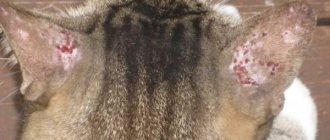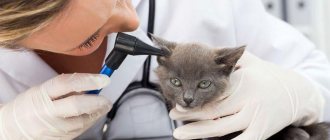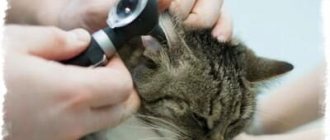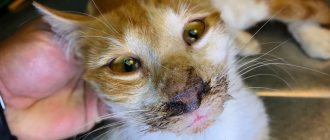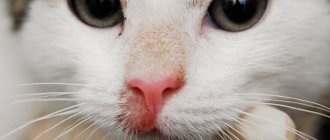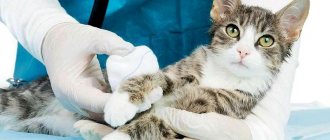Flea dermatitis in cats is one of the most common problems faced by lovers of these animals and from which not a single pet, even a carefully groomed pet, is immune. A similar reaction occurs as a result of an allergy to substances contained in the saliva of blood-sucking parasites. The initial manifestations of the disease can be noticed within ten to fifteen days after the flea bite, and the insects themselves may no longer be on the animal’s body by this time. It has been noticed that a cat with hypersensitive skin can react with a case of dermatitis after just two, or even one, flea bite. In this case, it is necessary to begin treatment immediately before the disease spreads to large areas of the body.
What is flea dermatitis?
Dermatitis is manifested by inflammation of the skin resulting from exposure to an irritant, that is, they are considered allergic diseases. For flea dermatitis to occur, it is not at all necessary that the pet be covered in fleas, since a couple of bites from random insects are often enough for its development. Young cats between nine months and three years of age, as well as those with short hair or hairless breeds, are considered to be most sensitive to such a reaction.
Up to two dozen different allergens can be simultaneously present in a flea's saliva, one of which is likely to lead to an allergic reaction.
The disease develops as follows:
- flea saliva containing the allergen after a bite gets on the skin or under the skin of the cat;
- the allergen penetrates the layers of the epidermis;
- subsequently it penetrates into the lymph;
- Together with the lymph, the allergen spreads throughout the animal’s body;
- in response, cells of the immune system initiate a protective reaction.
It has been noticed that manifestations of dermatitis occur not only at the internal level; quite quickly they also manifest themselves in the form of external rashes, which quickly progress and, if urgent measures are not taken, cause significant discomfort to the cat and even change its behavior.
Mechanism of infection
Did you know that, according to numerous testimonies from veterinarians, in 90% of cases, the majority of skin lesions in their patients are caused by representatives of the blood-sucking order? For some reason, many owners zealously deny the presence of fleas on their four-legged pets, which causes bewilderment among experienced specialists. Owners of small dogs, who “relieve themselves” in a litter box at home, like cats, especially suffer from this misconception. In their opinion, if a pet practically never appears on the street, then this unpleasant problem has nowhere to come from. It's time to dispel dangerous misconceptions.
The flea is a hematophagous insect and, as you probably know, they feed not only on the blood of animals, but also on people. Sensitive tiny insects are able to penetrate apartments and houses:
For the most part, you don't have to be the owner of a furry friend to attract a flea's attention. Without even meaning to, you yourself bring a parasite into your home, for example, on your clothes or dirty shoes.
As a rule, blood-sucking insects hide:
- in sofas;
- mattresses;
- in dust;
- under the parquet;
- in tile cracks;
- behind the baseboards;
- behind the wallpaper and in other secluded corners.
Almost the entire population of tiny bloodsuckers consists of larvae. For a whole year they exist unnoticed in human homes, waiting for their finest hour. And although the main period of outrage of insatiable creatures is considered to be spring, summer and autumn, it is the long stay in the pronymph (pupa) stage that makes these insects very viable and increases the likelihood of flea infestation even in winter.
As you have already understood: fleas are extremely tenacious and dexterous creatures. If a doctor suspects a tailed couch potato is infected with parasites, do not be reckless and deny the diagnosis.
Symptoms of flea dermatitis in cats
An allergic reaction caused by flea dermatitis cannot have a long latent period; diseases of this kind appear quickly and are quite pronounced.
The cat's behavior will begin to change, it will become restless, and upon careful examination of your pet, you can find the following:
- severe itching in a cat causes the animal to constantly itch; scratching in certain places with rashes can merge into limited weeping areas;
- changes in character are noticeable, the cat becomes restless, nervous, and may lose interest in food;
- in areas with rashes, hair loss, deep scratches and redness are observed;
- fleas and traces of their vital activity in the form of dark feces can be found on the skin;
- the rapid development of the disease leads to the formation of scabs in areas of scratching;
- the addition of a secondary infection threatens inflammation with purulent discharge.
A disease such as flea dermatitis can have an acute form, which can become chronic. The most affected areas of the skin are those located on the abdomen, around the ears, and on the back, and they tend to increase and gradually cover more and more new areas. If dermatitis occurs in a chronic form, then exacerbations of the disease are most often observed in the summer.
Types and symptoms of the disease
There are 2 types of disease: acute and chronic. The first is characterized by severe itching and redness of the skin. The chronic form is manifested by areas of baldness and the presence of inflammatory nodules. This form occurs when acute dermatitis is not treated in a timely manner and lasts for a long time.
Flea dermatitis is caused by fleas, which look like black specks that adhere tightly to the fur near the skin.
Symptoms of the disease:
- itching;
- the presence of multiple erythemas - inflamed areas of the skin;
- baldness in the affected area;
- changes in the cat’s behavior: she becomes irritable and itches all the time;
- loss of appetite;
- formation of seals on the skin;
- presence of scratching;
- weight loss.
In the presence of this type of dermatitis, the animal’s fur often becomes dull and may break off at the root. Constant scratching can lead to infection.
Attention! The presence of fleas in a pet is dangerous due to the occurrence of helminthic infestations, since these blood-sucking parasites are active carriers of helminths, which can subsequently lead to serious complications for the cat.
Kinds
Allergic flea dermatitis in cats can occur with varying intensity and some differences in the symptoms shown. Based on these features, the disease is classified into three types:
- Sharp look . Characterized by severe skin itching.
- Subacute appearance . It is an intermediate stage between the acute nature and the transition of the disease to a chronic form.
- Chronic appearance . It is characterized by the formation of nodules on the skin, also accompanied by itching. On damaged skin, hair loss occurs with the appearance of bald areas.
The acute form of flea dermatitis in cats can quickly become chronic, which occurs in the absence of timely treatment or if it is carried out incorrectly. The disease will return until the correct way to eliminate it is found.
Symptoms of the disease
In total there are about two thousand species and subspecies of fleas. Most of them are parasitic throughout the body, however, a few varieties live exclusively on the face, on and around the ears. Usually, it is almost impossible to notice these tiny creatures with the naked eye, unless the condition of the infected animal has become critical.
As noted earlier, many skin diseases are caused by flea attacks. According to French researchers in 1992, the breeds most susceptible to the saliva of these bloodsuckers are:
- setter;
- fox terrier;
- chow-chow;
- Pekingese;
- spaniel.
There are other equally allergic dogs, such as pit bulls and sharpeis.
The clinical manifestations of parasite infection will depend not only on the sensitivity of the animal, but also on the number of insects on its body. The main signs of infection are:
- restlessness, irritability, barking, whining;
- dry skin, the appearance of peeling and crusts;
- itching, accompanied by endless scratching and licking of the affected areas;
- alopecia, bald patches, excessive hair loss;
- scratches, papules, weeping eczema;
- formation of fibrous nodes in the back, lower back, inner thighs and abdomen;
- hyperpigmentation and thickening of the skin;
- the pet noticeably loses weight and looks bad;
- in some cases, a worried dog refuses to eat and appears lethargic and lethargic.
It is important that even single bites provoke a strong allergic reaction, for example, while walking on the street. Only in 30% of cases do animals experience a slow increase in symptoms.
Who is most susceptible?
Despite the fact that flea dermatitis is considered a fairly common form of allergy and is seasonal, not all animals suffer from this disease. For many of them, flea bites pass without a trace, causing only anxiety from the direct bite and not causing flea dermatitis in the cat. Cat breeds with short hair or completely hairless are more predisposed to such a reaction to substances contained in the saliva of parasites.
Particular attention should be paid to your pets during the warm season; it is during this period that the possibility of flea bites increases. Moreover, for this it is not at all necessary to be on the street; the owners themselves can bring them home on street shoes and infect the pet.
Symptoms: descriptions and photos
All diseases have distinctive signs. Dermatitis in cats is no exception.
Home diagnostics
In most cases, you can identify the presence of fleas in a cat yourself. To do this, you just need to watch your pet for a while.
If you want to make sure that your cat is allergic to fleas, it is recommended to pay attention to the following:
- severe itching, especially in the head and tail area;
- redness;
- blisters;
- swelling at the site of the wound;
- anxiety, mainly at night;
- a cat scratching certain areas until they bleed;
- regular biting (the animal can bite itself).
Fleas are also easy to spot if you carefully examine the fur and skin. The presence of parasites can also be indicated by small black dots - excrement that look like beads.
To find out that this is not just dirt, but flea waste, you just need to dip one of them in a glass of water. If it has dissolved and the liquid has turned a slightly light brown color, you can be sure that the cat is infected.
In cats, a flea allergy has the following symptoms:
- the presence of ulcers or dense nodules;
- excessive dryness of the skin;
- partial swelling in certain places;
- severe scratching (sometimes to the point of bleeding);
- high temperature of certain areas of the skin;
- presence of problems with digestion and appetite;
- excessive fearfulness;
- frequent meowing.
Important: the above signs may be signs of other diseases, so to make an accurate diagnosis and choose the right treatment, you should first consult a veterinarian.
How to diagnose fleas?
Flea dermatitis can be suspected in a cat based on some specific signs that are easy to detect if you pay close attention to it. You just need to take a closer look at the animal and pay attention to changes in its behavior.
If the flea infestation has not yet reached scale and is at the initial stage, then you can check your cat for their presence as follows:
- Place the cat on a clean sheet of white paper.
- Using a comb or brush, comb the animal's fur in different directions.
- Particles of skin, fur, or small black grains resembling dirt may appear on white paper.
- If these particles are crushed, brown or brown marks remain on the paper.
- These particles are flea feces, and the color confirms that the fleas are feeding on the animal's blood.
Such confirmation serves as direct evidence that the cat has fleas, even if there are no other symptoms of infestation. Only a veterinarian can confirm whether their presence is a cause for dermatitis. It is impossible to independently diagnose the flea form of dermatitis, since completely different diseases that do not depend on the presence of skin parasites often exhibit similar symptoms. If, during examination by a specialist, the diagnosis of flea dermatitis is confirmed, then the animal will be prescribed treatment in accordance with the breed and age of the pet, as well as taking into account the form of development of the disease and the degree of damage. Correct prescriptions will not only stop the external manifestation of the disease, but will also prevent its relapses.
What do fleas look like on cats?
Fleas are wingless brown insects with 3 pairs of legs, the last of which is better developed than the others and is used for pushing off the surface when jumping, the length of which can reach 1.5 meters. Their body is flattened laterally, its length is 2–2.5 mm.
The flea has a laterally flattened body and three pairs of legs; no wings
The flea is protected from external influences by a chitinous shell, on which there are multiple spines and outgrowths that help it stay on the surface of the skin and fur. The parasite has a piercing-sucking type of mouthparts.
The flea lives for about 2 years, and actively reproduces. Fleas lay eggs wherever they can, and the worm-like larvae that emerge from the eggs feed on dust, debris, and various contaminants. The larvae turn into pupae, which, under unfavorable external conditions, can remain viable in the external environment for up to 1 year. The entire development cycle of a flea under favorable conditions takes only 2–3 weeks.
Fleas are highly mobile and tend to change hosts. It is extremely important that the majority of fleas live in the room where the cat is kept, while on the cat itself the number of parasites does not exceed 5–10% of the existing number.
Fleas are carriers of diseases:
- hemobartonellosis - infectious anemia of cats;
- tularemia - a natural focal infectious disease;
- helminthic infestations: dipilidia - parasitism of cucumber tapeworm;
- dipetalonematosis - parasitism of small roundworms - microfilariae. The disease occurs in Africa, South America, and southern Asia.
Ways of flea infection
Flea infestation occurs when:
- direct contact with infected relatives;
- through bedding, toys, and care items infested with fleas, their eggs and larvae;
- fleas can live in an apartment, periodically attacking a cat;
- A mother cat with fleas infects her kittens with them immediately after their birth.
If a mother cat has fleas, all her kittens become infected.
Photo
As a rule, most cases of flea dermatitis can be easily diagnosed by external signs. If you carefully examine the skin of an animal, it reveals the characteristic manifestations of this skin disease.
So, in a photo taken from the affected area of skin you can see:
- characteristic scratches in the form of bloody deep scratches;
- swelling of the skin with the presence of nodes, blisters, and ulcers;
- areas of skin with excessive dryness;
- redness of the skin with pronounced inflammation;
- purulent discharge may be noticed, which is characteristic of an infection.
Despite the obvious severity of symptoms consistent with the development of flea dermatitis, the final conclusion about the type of disease must be made by a veterinarian. Therefore, treatment of the disease should be carried out under his control and with the help of medications prescribed by him.
Diagnosis of the disease
At the first change in your pet's behavior, immediately seek help from a veterinary clinic. Experienced specialists will quickly detect the problem and make a diagnosis.
The most common methods for identifying fleas are:
- Superficial inspection. Usually this method is not enough, since only in very advanced cases is it easy to detect the presence of insects on the animal’s body. In most cases, fleas are visible only on bare areas, for example, on the stomach, under the arms, and in the groin.
- Leaf and comb method. The doctor takes an ordinary white A4 sheet, sprinkles it generously with water and combs the dog’s lower back with a comb, as if raking fur and skin particles down onto the paper. Flea bodies are immediately visible on a snow-white surface without additional equipment.
- Microscopy of wool. If previous methods have not yielded results or the doctor continues to doubt the cause of the skin reaction, he will take a clump of hair for detailed examination under a microscope. This method is used to look for feces of parasites in the animal's fur.
- Cytology. A scraping is taken from the affected area and carefully examined in the laboratory using magnifying instruments. It is usually used as an additional technique to exclude other possible diseases.
- Blood analysis. Sometimes the doctor takes a blood sample, however, according to many veterinarians, this method is useless. Elevated levels of eosinophils in the blood indicate not only flea infestation, but also helminth damage.
Some clinics may ask you to show your ankles for signs of insect bites. Of course, the method is quite dubious and if the doctor does not offer another way to identify the problem, then you should turn to other specialists.
Treatment of dermatitis
Drug treatment of flea dermatitis in domestic cats is carried out according to a standard regimen, which involves the use of the following medications:
- drugs with anti-inflammatory effects;
- medicines with antibiotic properties;
- antiphlogistic nonsteroidal drugs.
When treating, you need to focus not only on the choice of medications that can cope with the flea form of dermatitis. It is equally important to create the necessary living conditions for the animal.
Antihistamines
To treat cats with symptoms of flea dermatitis, medications containing calcium sodium thiosulfate and hormones are used. With the help of calcium in the drug, it is possible to reduce vascular permeability, eliminate swelling and reduce itching. However, their disadvantage can be considered some features of application, when their administration involves only intravenous injections, which can only be done by a specialist.
The use of sodium thiosulfate is also carried out only intravenously and strictly in accordance with the prescribed course. Thanks to it, the allergic reaction is stopped, which relieves the cat of disturbing symptoms. Moreover, if you seek help early and start treatment in a timely manner with such a drug, you can completely get rid of allergies.
However, antihistamines occupy a special place in methods of therapy aimed against flea dermatitis. With their help, you can quickly cope with itching, and intended for animals, they do not have a harmful effect on their body. These medications are usually given to your cat for three to five days, after which only your veterinarian can decide whether to continue treatment or stop it. The most effective antihistamine medications for cats are prescribed Suprastin, Tavegil, Diphenhydramine or Zyrtec. Chlorpheniramine, which is taken orally twice a day, 2 ml, copes well with this task.
In some cases, antihistamines are not effective enough against allergies, then it is recommended to treat flea dermatitis using glucocorticosteroids.
Hormonal
Hormonal medications are very often prescribed for severe forms of allergies in animals. Typically, Prednisolone is used for these purposes, starting the course of treatment with a high dose and gradually reducing it. The dosage depends on the weight of the cat and its age, due to which the expected result with the elimination of the symptoms of an allergic reaction occurs in a short time. When carrying out treatment with hormonal drugs, it is necessary to take into account their downside, that is, their adverse effect on the vital processes of the animal’s body. Thus, their use may reduce immunity, disrupt metabolic processes, and complicate the processes of digestion and assimilation of food. It is for this reason that hormonal drugs should be used only if indicated for this type of treatment and not used for a long time.
Often a sick animal is offered local hormonal agents as a cream or ointment. Such a prescription is justified in case of contraindications to the use of systemic drugs.
Ways to eliminate the disease
Treatment is aimed not only at eliminating the symptoms of the pathology, but also at addressing the cause. First of all, anti-flea treatment is carried out. Additionally, drugs are used for therapy that eliminate the symptoms of itching and have an antiseptic and healing effect.
If there are other animals in the house, then flea treatment should be carried out on them too.
First stage: eliminating fleas
At the first stage, it is necessary to remove all parasites. Shampoos, drops and sprays are used for these purposes. Additionally, it is recommended to thoroughly wash your pet’s toys and change the bedding, otherwise there is a high risk of re-infection.
One of the popular shampoos that is used is Rolf Club. The product contains permethrin, which has an effect on parasites. After washing the cat, it is enough to comb out the dead fleas with a furminator. This German-made product is easy to apply and foams, kills not only adult parasites, but also their larvae. In addition to these properties, the shampoo moisturizes the skin and makes hair easier to comb. One-time use is sufficient.
Rolf Club flea shampoo is suitable for all cat breeds
Another popular and effective shampoo is Bars. The composition includes a large number of essential oils, clove extract, glycerin and other natural ingredients. This product is active not only against fleas, but also against ticks. A single application is enough to eliminate parasites. In addition, the shampoo has a beneficial effect on the condition of the pet’s coat, making it shiny and silky.
Flea shampoo Bars gets rid of not only fleas, but also ticks
Antiparasitic shampoo from Gamma, designed specifically for cats, is also in demand. This product is effective against fleas and lice. The shampoo has an orange scent, is easy to apply and foams well. The active ingredient is permethrin. Shampoo is used once. Reapplication is possible after 10 days.
Antiparasitic flea shampoo contains herbal extracts
How to use anti-parasite shampoos correctly:
- Wear rubber gloves.
- Wet the animal's fur, avoiding getting water into the ears and eyes.
- Apply the selected shampoo, distributing it evenly over the body and foaming.
- Wait a few minutes and rinse thoroughly with water.
- When the fur is slightly dry, comb your pet thoroughly.
To eliminate the parasites that cause flea dermatitis, special sprays are also used, one of which is Beaphar Spot On Spray. This remedy can even be used to treat pregnant cats, as it is safe and effective. The composition includes soap alcohol and a complex of essential oils, which have a detrimental effect on blood-sucking parasites.
Beaphar Spot On Spray eliminates fleas thanks to its soapy alcohol content.
An effective parasite spray that can be used for cats, Rolf Club 3D. Used for treatment and prevention, it is easy to apply and does not cause any discomfort to the animal. However, it is important to ensure that the cat does not lick the contents immediately after treatment. To prevent such a nuisance, it is recommended to use a special collar. The spray contains fipronil, etofenprox and pyriproxyfen. These components are active against ticks, fleas and other blood-sucking parasites. 1 bottle is enough for two treatments.
Rolf Club 3D spray for cats is valid for a month
And another spray that is popular is BlochNet. This product contains benzyl benzoate and fipronil. These components are active against fleas, lice and other parasites. The spray can be used to treat not only the animal’s fur, but also its bedding, which is important as a preventive measure.
BlochNet spray can be used to treat bedding
How to use sprays correctly:
- Wear gloves.
- Shake the spray and distribute the contents evenly over the pet's body, avoiding the ears, area around the eyes and genitals.
- If possible, put a collar on your pet to prevent him from licking off the product.
- When the spray dries, comb the coat.
To eliminate fleas, drops are also used, which are very convenient to use. The most popular are Advantage from Bayer. The active ingredient is imidacloprid, which has an effect on parasites after absorption into the surface of the pet’s skin. The drug promotes the death of fleas, which occurs immediately after a cat bite. The drops are valid for up to 4 weeks. All parasites die within 12 hours after application of the product.
Advantage drops against fleas can be used to treat adult animals and kittens
Another effective drops are Inspector, which can be used from the age of 7 weeks. The duration of action is 2 months, which is very convenient and effective. The drug gets rid of not only fleas, but also helminths. The drops do not have a pungent odor and are produced in a special pipette, with which the product is easily applied to the withers. The active component of the drug is fipronil.
Inspector drops against fleas and helminths have a wide spectrum of action
Frontline drops are also often used to eliminate blood-sucking parasites. The medicine contains fipronil and methoprene, which have a detrimental effect on ticks, fleas and lice. After applying the product, the animal should not be bathed for two days. The drug remains active for about 8 weeks, so re-treatment is not required.
Frontline drops for cats do not require reapplication
How to use drops:
- Wear gloves.
- Have another person restrain the cat.
- Spread the hairs on the withers and apply the product.
- Release the animal, remove gloves and wash your hands thoroughly.
Each product must be purchased according to the weight of the pet. Therefore, before going to the veterinary pharmacy, it is recommended to find out the animal’s body weight.
When I had a cat, I always used drops to prevent fleas. Unlike sprays and shampoos, this product is most convenient to use. In addition, the drops have a complex effect. They also have a detrimental effect on ticks and worms, so there is no point in additional deworming. I also tried shampoo, but it was inconvenient to use. The cat breaks out all the time, and you can’t wash off the product immediately after application. You need to wait a few minutes, which seem like an eternity. Therefore, I recommend everyone to use the drops, there will be less stress for the animal and the owner’s hands will be healthier.
How to properly treat an animal for fleas - video
Stage two: drug therapy
To eliminate itching, antihistamines are used, which have a direct effect on the symptoms of dermatitis, eliminating swelling and redness. Most often prescribed are Tavegil, Cetirizine, Suprastin and other medications. The dosage of these medications is discussed with a veterinarian, since the drugs are intended to eliminate allergies in humans.
Based on the weight, the required amount of product is selected. Most often, the dosage varies from a quarter to half a tablet, which must first be crushed, mixed with water or food and given to the pet. These drugs affect the production of histamine and have a mild sedative effect, so if your pet sleeps more, it’s okay. The course of treatment often does not exceed a week. Medicines in this group act for almost a day, so a single dose per day is sufficient.
Suprastin relieves itching
If, during active scratching, an infection gets under the pet’s skin, the veterinarian will prescribe antibacterial ointments. One of these drugs is the drug Iruxovetin, which has a wide spectrum of action against streptococci, staphylococci, E. coli and other microorganisms. The ointment is applied to the affected areas of the skin 2 to 3 times a day. The course of treatment is determined by the veterinarian.
Iruxovetin ointment destroys pathogenic microflora
Antibacterial ointments are also used to treat animals, which are used to eliminate infections in humans. These drugs include the drugs Tetracycline and Erythromycin. The products are applied 2 times a day for the course prescribed by the doctor. These drugs destroy a wide range of bacteria, promoting healing of damaged areas.
Tetracycline ointment affects a wide range of microorganisms
Additionally, healing creams can be used for treatment, which promote the regeneration of damaged tissue. For these purposes, Ranosan, Levomekol, etc. are prescribed. The first drug is used specifically for the treatment of wounds, abrasions and postoperative scars in animals. This remedy is also effective for skin damage caused by dermatitis. Levomekol is used to accelerate the healing of a wound or nodule that forms in the chronic form of the disease.
The drug Ranosan promotes the healing of damaged tissues
Antihistamines and antibacterial drugs, if necessary, are prescribed only by a veterinarian. You cannot select the dosage and course of treatment on your own, as this can cause a number of consequences.
I recommend giving antihistamines to cats on an empty stomach, since the medications are mostly very bitter (especially Suprastin). The animal may vomit. I usually give such products in combination with a small amount of water, then immediately pour in the food so that the cat eats and the unpleasant taste quickly disappears.
Video - How to give a cat a pill
Often there is a need to treat a pet with tablets and then the question arises: what is the best way to do this?
To do this, you can use the recommendations of specialists or watch the video:
- Carefully study the instructions for the drug and determine the prescribed dosage.
- Decide on the permissibility of giving the medicine with food or dissolved in water.
- Limit the animal's mobility by wrapping it tightly in a thick blanket or towel.
- Raise the cat's head and open its mouth.
- It should be taken into account that the animal will struggle, so it is necessary to hold it still with your free hand.
- By pressing on the lower jaw, it is necessary to open the mouth. Moreover, if you are supposed to give a pill, the mouth must be opened as wide as possible.
- The tablet is inserted with two fingers, trying to get as far as possible to the root of the tongue.
- You must make sure that the tablet is swallowed. To help with this, you can blow lightly into your cat's nostrils, which will trigger the swallowing reflex.
- Release the cat from the blanket and offer it water.
If the animal is strong enough and actively resists, and the fear of inserting fingers into its mouth turns out to be stronger than the desire to help it, then you can insert the tablet using special plastic tweezers, which can be bought at a veterinary pharmacy.
Top 4 best drops
Drops containing insecticides help achieve the best results in the fight against annoying bloodsuckers. Check out the highest quality, most effective and modern products:
- Bars AVZ. A universal remedy, suitable for both adult dogs and puppies. The protective effect lasts for a month. Does not cause side effects.
- Advantix for large breeds from Bayer. It does not penetrate into the pet’s blood, but remains in the sebaceous glands. Designed for large mature dogs weighing over 25 kg, as well as for growing young animals from seven weeks of age.
- Advantix for medium breeds from Bayer. Does not leave excess oil on the coat, protects against any midges and is considered a hypoallergenic product. It is better to use it together with a flea collar from the same manufacturer.
- Frontline Combo S Merial. It is also not absorbed into the blood and destroys eggs and larvae. Using a special bottle, it is convenient to apply the solution directly while walking.
It is important that after using antiparasitic agents, it is better to put a special collar on the animal, which will prevent the dog from licking the strong-smelling liquid.
Diet
When relieving a pet of the symptoms of an allergic reaction to flea bites, it is necessary to help the body cope with this change in its condition with the help of special nutrition. Thanks to this, the skin healing process will happen faster, and inflammation and itching will disappear. If the cat eats natural food, then it is necessary to add Omega-3 acid, for example, Nordic naturals Omega.
If you prefer dry ready-made food, it is better to use Royal Canin Skin or Econuba Dermatosis. For a while, it is necessary to give up chicken-based food and not give chicken as food, since it is this type of food that most often contributes to allergies.
Description of the problem
Flea dermatitis is an inflammation of the skin that occurs as a result of flea bites and an allergy to the saliva produced. The severity of symptoms does not in all cases depend on the number of fleas; sometimes a few bites are enough. According to statistics, an allergic reaction is the main cause of itching in pets. There is no pronounced seasonality, but symptoms are often observed in summer and autumn.
Drops
To eliminate the discomfort caused by flea dermatitis in cats, you can use special drops designed for this purpose and approved for the treatment of allergies in animals. In this capacity, veterinarians advise using the following types of liquid preparation:
- Essential 6 - with the help of this product, the animal quickly gets rid of itching, and they also serve as a guarantee to prevent repeated cases of infection. An additional advantage is the packaging with a small dosage;
- Stronghold are drops that can be used for adult cats and kittens from three months of age.
Using these remedies, you can get rid of parasites on the animal’s body within 24 hours, thereby it will stop suffering from itching and anxiety.
Additional Notes
As you can see, a seemingly harmless disease can do serious things. That’s why prevention is “our everything.” The simplest and most effective means of preventing flea infestation is a collar. Today there are dozens of varieties on the market, from a wide variety of companies. Don’t forget to change the collar on time, and your cat will be reliably protected from small bloodsuckers. Insecticidal drops and simple wormwood oil have also worked well, which also repels fleas well; you can use tar soap.
In addition, do not forget to clean the room more often, paying special attention to wet cleaning of the most remote corners of the apartment. In this case, it is very useful to add insecticidal preparations or simple chlorine bleaches in good concentrations to the water for washing floors. This way you are guaranteed to destroy all the larvae, and the flea population will not increase.
Powder
You can alleviate the condition of an animal when it develops allergic dermatitis as a result of a reaction to flea bites using powder. Most often, powders such as:
- Tsamaks - has wound-healing properties;
- Synthesis - when applied to damaged skin, accelerates its healing, and also effectively relieves inflammation and swelling.
The combination of components in these powders allows you to quickly cope with a problematic situation.
Symptoms
What are the symptoms of this disease? The dog itches, bites, chews itself out, constantly scratching and damaging irritated areas of the body. May jump up suddenly to scratch. Favorite places for fleas to bite are the base of the tail, the back of the back, the groin, and the neck. Itching and lesions in these places can most likely indicate flea allergic dermatitis. If flea allergy symptoms are not treated promptly, it can lead to hair loss, bacterial growth, and serious skin problems. Even just one flea bite on a sensitive animal can cause a serious allergic reaction. On the Internet you can see a huge number of photos of flea dermatitis in dogs. These photographs do not make me smile. Dogs want to be helped as quickly as possible.
Collar
Using a collar will not get rid of parasites, but it will protect a clean and healthy animal from their penetration. Most often, the following types can be purchased in veterinary pharmacies:
- Leopard - capable of reliably protecting a cat from fleas for seven months, since its characteristic smell repels parasites;
- Baffo - the impregnation of this collar is distinguished by a large number of anti-parasitic components, but they can only be used on animals older than three months.
You should not assume that using a flea collar does not pose any danger to the animal itself. There are cases, however, so far isolated, that the composition used for impregnation can also cause allergies.
Fighting the disease at home
Traditional medicine is used as alternative treatment methods. However, this method does not exclude the professional prescription of a specialist. Rather, this is regarded only as additional measures to alleviate the condition of a mustachioed patient, but certainly not as a panacea for the disease.
- Soap solution. One of the most popular techniques to relieve itching and remove skin rashes. Essential oils of cedar, tea tree and lavender are mixed in equal proportions with soap foam. The resulting composition is used to treat the animal’s fur before and after bathing. The owner will have to be patient, because the results of such treatment will not appear soon.
- Lotions. Infusions of chamomile, fireweed, celandine, burdock, and plantain will help reduce unpleasant symptoms. Usually a compress is applied to the affected area or the surface of the skin is wiped with a cotton swab soaked in the broth.
- Medicinal ointments. You can also make your own special paste. Take one tablespoon of all the above plants and mix with 400 ml of hay dust brew. The resulting mixture is poured with boiling water and steamed in a “bath” for about 5-7 minutes. Then filter the cake and add about fifteen grams of butter to the liquid and keep it on the fire until the mixture thickens. Then add another 15 grams of glycerin and apply to the damaged areas for a month four times a day.
- Chlorhexidine. Based on this antiseptic, various sprays and shampoos are produced that relieve inflammation, prevent infection and have an antimicrobial effect. It is allowed to use a regular 1-2% pharmaceutical solution. It is enough to gently wipe the inflamed area with a moistened cotton pad.
- Hydrogen peroxide. Popular antimicrobial agent. It is better to buy a 3% solution.
- Nutrition. During the acute stage and until stable remission occurs, the animal can be given hypoallergenic food. But it is better to exclude beef, wheat and fermented milk, which provoke allergies. Suitable natural foods would be: pumpkin, turkey, potatoes.
- Vitamins. Be sure to support the dog’s immunity, which is weakened by the fight against the unfortunate allergen. Here you will still have to consult a doctor, since prescribing supplements to your pet at your own discretion is highly not recommended.
In conclusion, I would like to remind you: if you develop hypersensitivity to flea saliva, it will be impossible to completely get rid of this type of dermatitis. The problem will be relevant until the onset of the first cold weather. Then the temperature outside will become unsuitable for fleas and the insects will go into hibernation.
During the warm season, it is recommended to constantly treat dogs prone to this infection. Try to avoid areas with tall, dry grass, where these obnoxious insects like to settle.
And finally, I would like to note that properly functioning anal glands in a pet directly affect the barrier function of the skin. It is important to regularly maintain and keep the area clean. If it is difficult to do this procedure yourself, seek the help of specialists. If these glands work well, it will be easier for your pet to tolerate flea dermatitis.
Be attentive to your four-legged friends. Do not neglect taking care of their health and bring your animal to the veterinary clinic for examination on time.
Shampoo
As an effective remedy against fleas, special shampoos can be used, which are presented in a large assortment, namely:
- Kiss shampoo - produced in Sweden, it simultaneously kills insects and moisturizes the skin;
- Rolf Club shampoo is a product considered the most effective against fleas, but its more aggressive composition does not allow its use on animals under three months of age.
Many types of shampoos intended for animals, in addition to getting rid of parasites, gently care for the skin, prevent dryness and flaking, and the coat becomes silky and thicker.
Brief description of the disease
Flea dermatitis is an insect allergy or intolerance to parasite bites. Digging into the skin, the bloodthirsty parasite injects saliva, which prevents blood clotting and, when it gets into it, causes severe intoxication. This colorless liquid contains about fifteen different substances that cause unbearable itching.
In general terms, dermatitis is severe skin irritation caused by allergens. According to statistics, the majority of such reactions in dogs (about 80%) are caused by these small blood-sucking reptiles.
This disease usually affects animals between two and six years of age. Puppies under six months of age are not susceptible to this scourge, since their immunity is too weak and will not give a strong response to the allergen.
Spray
Topical sprays are most suitable for contact allergies and flea dermatitis caused by a reaction to fleas.
- Nartz spray has the advantages of a large volume and the presence of several types of the drug, allowing it to be used in accordance with the age and weight of the animal. It has hypoallergenic properties and can be used from one month of age.
- Front-line spray - due to its sufficient volume, it allows you to extend use up to one and a half years, and one application protects the cat from fleas for up to 40 days.
The use of a spray allows you to relieve the animal from itching and obtain an antibacterial and anti-inflammatory effect.
Reasons for the development of the disease
Fleas are year-round parasites that can live and breed anywhere. Those who live in basements and entrances of houses are especially dangerous. From there, on their own, on the folds of clothing or on the soles of shoes, they get into apartments and jump on pets. Thus, most often a cat becomes infected with flea dermatitis in the following ways:
- in the entrance, if he accidentally jumps out there; - through a person, since fleas can get into the apartment on his clothes and shoes; - through a dog, since it can easily bring parasites home from the street after a walk; - during self-walking.
Read more about the dangers of self-walking: Self-walking - when freedom means death
This is why kittens that have never left the apartment are susceptible to flea dermatitis. Since flea dermatitis is caused by allergens from the saliva of parasites, the following are most susceptible to this disease:
- individuals prone to allergies; — kittens, since they have weak immunity; — weakened animals (sick); - representatives of some breeds (especially hairless); - older cats.
Traditional methods of treating fleas in cats
You can try to alleviate the animal’s condition and treat flea dermatitis in cats at home using traditional methods that will complement the main treatment with medications. To do this, they often use a composition of equal parts of olive and lavender oils and soapy water. Soak a cotton pad in the solution and apply it to the surface of the skin before and immediately after bathing the cat.
The same effect, eliminating irritation and swelling, as well as relieving itching, can be obtained by rubbing with chamomile decoction.
However, if your veterinarian does not recommend using such methods on your animal, then it is better not to use them.
Treatment
The only effective treatment will be to eliminate parasites and carry out a complete disinfestation of the premises. In this way, you can not only return the animal to a full life, but also prevent possible relapses. It is necessary to fight the disease as early as possible, otherwise the skin in places will become thick and begin to become rough, and the disease itself will become chronic.
Drops
These products are the safest. As a rule, emulsions with fipronil, permethrin or fenthion are prescribed. The preparations are applied to the skin of the withers so that the cat cannot lick it until it is completely absorbed. You can swim two days after applying the products.
Sprays
They contain organochlorine compounds. When applying sprays, you need to be careful not to harm the animal or yourself. Cats are wearing protective collars to prevent licking.
Shampoos
Helps soothe skin inflammation. They should be used with caution, strictly following the instructions. This is especially true for bathing kittens. The main component of shampoos is the insecticide permethrin.
Collars
The principle of operation is quite simple - scare and destroy. The products are impregnated with special preparations that repel fleas. A membrane that is invisible to the eye is formed near the neck. And those parasites that already live on the fur will be destroyed by a specific smell. The shelf life of one product is 4 weeks-6 months.
Collars are divided into several categories: depending on age (for adults, for kittens, for cats during pregnancy) and according to how they act (based on insecticides, aromatic oils and herbs, ultrasound). Used primarily for preventive purposes.
Antihistamines
Good for eliminating allergic reactions in humans, but not so effective for animals. Loratadine or its analogues will not be able to completely relieve a cat’s allergies. They act as aids.
Hormonal drugs
Doctors often prescribe prednisolone or its analogues. The course of treatment will be long, starting with large doses, all the time reducing them to the minimum. They have a good effect, flea dermatitis recedes. The dosage is selected individually. But they should be used only in extreme cases due to numerous side effects on all systems and organs.
Folk remedies
They do not replace traditional therapy, but are used as an addition to it. An effective recipe is: lavender, tea tree, cedar oil in equal quantities and soapy water. The resulting mixture is used to treat the skin before bathing and after water procedures.
Accompanying illnesses
Flea dermatitis is dangerous due to its complications, the most common of which are:
- development of atopic dermatitis, ending in the formation of lesions;
- the addition of bacterial infections, accompanied by vomiting, diarrhea and symptoms of fever.
If this happens and the cat’s condition does not improve within a few days, then you should immediately consult a veterinarian. To prevent the development of concomitant diseases and complications, it may be necessary to review and change the prescribed treatment regimen.
Diagnosis of the disease
The first symptoms of the disease should lead the owner and the cat to the veterinarian for a more accurate diagnosis, which will help prescribe the necessary treatment:
- First, a visual inspection of the pet will immediately determine the presence of fleas and their feces on the animal's skin.
- A blood test will help determine whether there are abnormalities in the form of a decrease in the number of red and white blood cells. This is extremely important, because if you miss this moment, the cat may die due to the exhausted state of the pet.
Prevention
Today there are no effective remedies that could completely protect against allergies to flea bites. To prevent their pet from suffering from flea dermatitis and its complications, owners must protect it from the possibility of infection.
To do this you should:
- do not allow street walks;
- when traveling to the country, pre-treatment against fleas is necessary;
- in case of high humidity, it is better to reduce walks in the air to a minimum;
- Carry out a thorough monthly inspection of the animal for the presence of fleas, and repeat treatment with drugs that have not expired;
- carry out wet cleaning more often in the room where the cat is;
- treat upholstered furniture and carpets with antiseptic agents;
- When you come home, do not leave dirty shoes in the hallway, but after washing them, put them in the closet.
If your pet has undergone treatment for dermatitis and it was successful, it is recommended that its condition be monitored by a veterinarian for several months. This is necessary for timely action in case of relapse.
Disease prevention
Flea dermatitis is easier to prevent than to cure. Disease prevention:
- Treat your cat for fleas and worms every six months.
- Limit your cat's time with other animals.
- Do not let the animal go outside.
- If your cat is outdoors, put a flea collar on her.
- Wash the soles of your shoes as soon as you get home.
- If you have been in contact with another animal, wash your hands afterward.
- Maintain a varied diet for your cat.
- Keep the pet's bedding and the room in which the cat is kept clean.
- Veterinarians recommend having your pet examined at a veterinary clinic once every six months.
- Sometimes wash your pet with special shampoos for cats.
- Brush your cat's fur with a brush several times a week.
Even if your pet does not go outside, does not come into contact with other animals and does not leave the house, this does not mean that the cat cannot pick up fleas. It is very easy to bring parasites along with some object or on your clothes.
Fleas do not live on animals, but only feed. Accumulations of fleas can be found in carpets, under furniture, and in dusty corners of the apartment.
